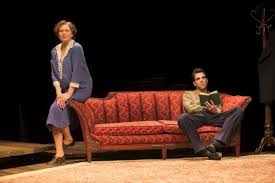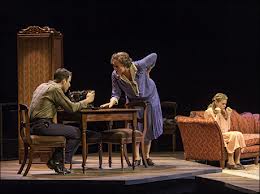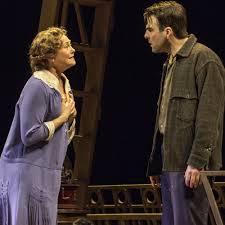

If you direct students at any level, community members, and/or professionals, you want to give them all the power they possibly can possess on stage. However, many times directors undercut their actors without realizing they are doing so. Often this occurs because the director lacks a proper understanding of how distance on stage can work. In a previous blog we discussed how geometry, specifically diagonals, arc, and triangles, can help actors be more effective on stage.
Physical distance on stage can also be a major tool that directors can use to create interesting scenes that allow actors to utilize the emotional content of a scene fully. In this article will consider physical/emotional distance in relationship to the third scene in Tennessee Williams’ The Glass Menagerie. This scene highlights the escalating tensions and frustrations between Tom and his mother Amanda.
Physical/Emotional Distance
Keeping actors at a distance from one another, gives the actor room to move towards that other actor when emotions are building. Saving face-to-face encounters or even being within a few feet of one another for special times, when emotions are heightened allows you to use physical space and distance to show, support, and create emotion on stage. Depending on the size of the stage, at least 8 to 12 feet between actors will allow them the room they need to use physical/emotional space when needed.
How to Use It: Tom and Amanda

Consider the third scene in Tennessee William’s The Glass Menagerie when Tom and Amanda argue and at the end of the scene he calls her an “ugly babbling old witch.” Amanda has been picking at him throughout the scene and he has been trying to get away from her. As he exits the apartment she says to him that she does not believe that he is actually going to the movies. That moment is punctuated by Amanda’s short but harsh line, “I don’t believe that lie.”
Tom stops and enters back into the apartment. He then has a major monologue where he makes up a ridiculous story as to what he really does at night. The monologue ridicules Amanda, expresses Tom’s growing anger and frustration with her, and ultimately end with him insulting her in a vicious manner. As Tom goes to leave the apartment again, he struggles with his coat, rips it, takes it and throws it, hitting Laura’s glass menagerie which is across the stage. At the end of the scene Tom and Laura are physically close together at the glass menagerie, picking up the ornaments and trying to set everything right.

It would be a mistake to have Tom play the beginning of his monologue next to his mother. In fact, his physical and emotional demeanor is such that she would probably want to give him distance. In this monologue the actor playing Tom needs physical/emotional distance, which he can use to his advantage as the monologue build to the ultimate insult. Thus, keeping Tom away from Amanda gives him the physical distance to show how angry he is by crossing to her at the end of the speech and getting in her face an insulting her. Without having that distance to play with, the actor’s power and that final moment of the monologue is severely weakened.
Using Space Effectively
As it is with incorporating geometric shapes into your staging, the use of physical/emotional distance allows you to effectively utilize space on stage. Keeping actors apart and bringing them close together during moments when emotions are extreme, whether they be violent or intimate, is especially effective.

 Random Item
Random Item